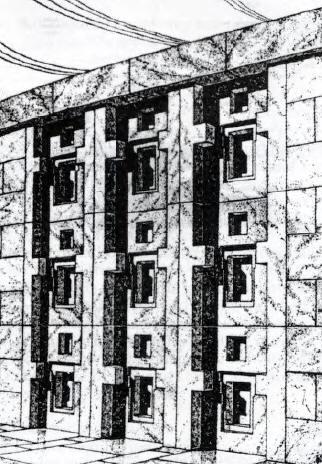Grid of the Gods (27 page)
Authors: Joseph P. Farrell,Scott D. de Hart

Part of the Nazca Lines in Peru. Note the Straightness of the Lines
This has led some in the “ancient astronauts” school to propose that the lines were direction markers in some ancient “spaceport.” But then, how does one explain these parts of the Nazca Lines, also only visible from the air?

Nazca Lines in Peru with the Famous “Hummingbird” Glyph
More recent investigations have shown many of these glyphs, the “Spider”(not shown) and the “Hummingbird” to be configured, once again, to certain astronomical alignments.
Turning south from Peru towards Bolivia, the area surrounding Tiahuanaco is even stranger, for there the system of straight “ley lines” is even more in evidence from an aerial view of the Aymara Indian country surrounding Lake Titicaca, the site of Tiahuanaco.

Straight Ley Line System in Aymara Indian Country in Bolivia, Near Lake Titicaca.
And this brings us to the strangest ancient site in South America, and perhaps even the strangest of all sites on the world Grid, Lake Titicaca, and the curious ruins of Tiahuanaco and Puma Punkhu.
B. Tiahuanaco and the Puma Punkhu Paradox: Ancient Machining
No one visiting Tiahuanaco and Puma Punkhu can come away with anything less than awe and puzzlement, for there, amid the ruins of what was clearly an ancient city, high in the thin air of the lake, are the great stone remains of a civilization that clearly possessed an advanced technology able to machine the intricately cut stones. As we shall see, the presence of such clear evidence for a sophisticated stone-working technology raises in a clear fashion the possibility that one is looking at the debris of a very ancient civilization, remains that have led many to question the whole standard history and model of how mankind came to the South and North American continents.
Just a glance at some of these will demonstrate this point better than any words could possibly do.

Intricate Stone Cutting at Tiahuanaco
12
More than any other of the huge stones at Tiahuanaco, the so-called “H Blocks” — huge stones intricately cut — testify to the existence of some sort of technology, to the existence of some sort of advanced ancient
machining
technology:

Trapezoidal Cuts in an “H-Block” at Tiahuanaco
13
And not far away, at Puma Punkhu, are the famous “H-Blocks” themselves:

“H-Block” at Puma Punkhu,
14

Twin “H-Blocks” at Puma Punku
15
When engineers carefully examined these huge, finely-cut blocks, they discovered something else: the cuts were so placed on each block that the bocks were meant to be joined together, as if they were three-dimensional pieces of an intricate jigsaw puzzle.

Artist’s Rendition of the Joining of the H-Blocks
16
The mystery only deepens, the closer one looks, and one researcher who
did
take a closer look was my friend and colleague in alternative research, Igor Witkowski.
Best known for his truly magisterial research in the field of Nazi technology,
The Truth About the Wunderwaffe
,
17
Witkowski turned his
investigative talents to the question of human origins in the Americas in a fascinating study,
Axis of the World: The Search for the Oldest American Civilization
, a work we shall follow closely in this chapter, for Witkowski’s conclusions are nothing less than stunning, and his book also makes available for the first time in the English language some of the investigations into these mysteries undertaken in Eastern Europe.
1. The Heart of All South American Mysteries
Witkowski justifiably calls Tiahuanaco and Puma Punkhu “the heart of all the South American and Transpacific mysteries.”
18
We shall see presently why he says that it is at the heart of the “Transpacific” mysteries. As has already been seen with the pictures of the elaborate stone-work of Tiahuanaco and Puma Punkhu, however, the site “is a perfect illustration of a certain ‘challenge’ to
all
the theories, namely that it experienced a period of uncanny technological progress, followed by an equally unexplainable period of deterioration,”
19
for “the precision of stonecutting visible here and the level of its complexity are
evident
remains of some technological civilization’s activity.”
20
This problem is compounded by Tiahuanaco’s and Puma Punkhu’s location at Lake Titicaca in Bolivia, at an altitude of nearly 10,000 feet above sea level, an altitude of such thin air that only the nearby Aymara Indians are accustomed to breathing and working in it; for Europeans such as Witkowski, the effort often produces nosebleeds, exhaustian, and pre-heart attack symptoms.
21
How could such a technologically sophisticated civilization emerge or settle in such an extreme place?
The problem is further compounded by the fact that the gigantic machined stones of Puma Punkhu are scattered chaotically over the
site, as if smashed by some heavy hand of destruction.
22
To Wiktkowski, when one considered all the various sites evident in South America and the varying degrees of technological sophistication they exhibited, it was evident that the most recent Inca period was the least sophisticated. The further back one went, the more the evidence suggested that the technology itself was far superior in remotest times, than more recent ones. This suggested something of great significance for the
chronological
development of the South American civilizations to Witkowski, when one compared the great technological sophistication of Puma Punkhu, to the less sophisticated level of technology evidenced by nearby Tiahuanaco:
Looking at the site we have the overwhelming impression that we deal here with a
backward development
from an advanced, sophisticated technology in the remote past, through a moderately developed technology in nearer history, up to its almost complete atrophy presently.
When taking into account modern construction achievements, we face the truth that
many of the construction methods that were applied in Puma Punkhu have absolutely no equivalent anywhere else in the world and would even be hard to reproduce in our time.
23
In other words, we have the following broad outlines of a tripartite structure of chronological and technological development:
